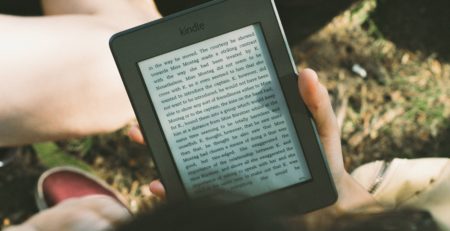Innovations in the publishing sector
Despite having a long history, publishing has constantly been on the cutting edge of innovation, with its key technology, the book, still holding potential for exploitation and evolution, not only due to its recent digital transformation. As the representative of European Publishers, FEP has an overview of several developments in the publishing sector, innovative solutions being developed to tackle issues spanning from reading with smartphones to making books more accessible and greener, and so on. The following is only a small selection of promising developments taking place at the moment, and who knows? They might become the standard for the future of books!
Immer
Designed by the Netherlands-based team founded by Niels ’t Hooft and Lennart de Meij, Immer – for Immersive (in English) and always (in German and Dutch) – is an app and reading ecosystem currently under development but that already won the Renew the Book Innovation Award in 2021. Immer is designed to rethink reading in the time of smartphones. It allows users to exploit the nature of their devices and tailor their reading to their tastes and patterns, building user-centric, efficient reading habits. Rather than simply filling the screen with text, Immer adapts the text to the screen thanks to a proprietary semantic engine. The text is broken into meaningful units, allowing for deeper reading and understanding.
Furthermore, to better adapt reading to smartphones, Immer utilises typographic conventions and indicators developed ad hoc for the app, to reinvent the haptic feeling of the book for the screen, developing new tools to bring the enjoyment of reading to people that cannot put their phone down! Currently the Immer reader is in early access, available here: https://immer.app/product/
READ-O
READ-O is a German app that placed first along with BotTalk in the 2021 edition of the CONTENTshift accelerator sponsored by the Börsenvereinsgruppe. READ-O helps readers discover their new book by an innovative use of artificial intelligence. Rather than basing its suggestions on consumers’ purchases or ratings, it scans reviews of books and maps the emotions expressed by readers. Then, it suggests books based on what kind of feelings its users are looking for in their next stories.
BotTalk
Tied for first place with READ-O for the 2021 CONTENTshift accelerator, BotTalk is an advanced Audio Content Management System (CMS) designed for producing high-quality text-to-speech files with great ease of use.
BotTalk’s software is one of the most advanced currently available and its audio output is extremely lifelike. It achieves this standard using an extremely complex set of rules for pronunciation, timing, etc, for several languages, and by using machine learning to adapt to different content formats. Furthermore, BotTalk allows users to adapt their audio files on the go by adding specific pronunciation rules for names, locations, and overall any word the system doesn’t immediately and automatically recognise. Rules and dictionaries created by users can be then shared to keep BotTalk always updated. BotTalk is also flexible enough to adapt to publishers’ needs: Paywall-integration, audio ads, and content selection. Publishers can also audify their articles by adding BotTalk Player to their website. The results are undeniable: 10% click rate, 75% listen till the end and 2,5 minutes higher dwell time.
Accessibility practices
Digitalisation is a big opportunity for making accessible books. Digital flexibility allows for texts to be adapted for readers with different impairments. Fondazione LIA, an internationally recognized leader in accessibility, uses several tools to make books accessible for all readers. For example, its catalogue of accessible ebooks, Libri Italiani is navigable using an audio assistant, so that visually impaired readers can search for titles simply using their voice. The catalogue offers the possibility to search LIA ebooks using queries via tools such as Amazon Alexa or Google Assistant.
LIA recently promoted a research project on the automation of image description via Artificial Intelligence, to simplify and possibly automate the process of describing images. The first phase of the research showed how current algorithms are focused on photograph recognition rather than images e.g., drawings, graphs, etc and used mostly for web content, rather than books. Thus, LIA is promoting activities to expand the use of AI in this direction.
Sustainability practices
Finally, innovation isn’t only created via new reading technologies or apps; publishers might also innovate by renewing established practices, in this case making them more sustainable in the long run, renewing their processes and making their activities greener. Publishers are experimenting with cradle-to-cradle production models, in which products are not part of a downcycling approach to waste management but are rather part of an upcycling one, which mimics biological processes and produces zero waste. Other practices make publishing production lines less and less impactful thanks to greater attention to sustainable forest management and optimisation of the distribution and return activities. Better consumer data allows having less waste at all levels.












